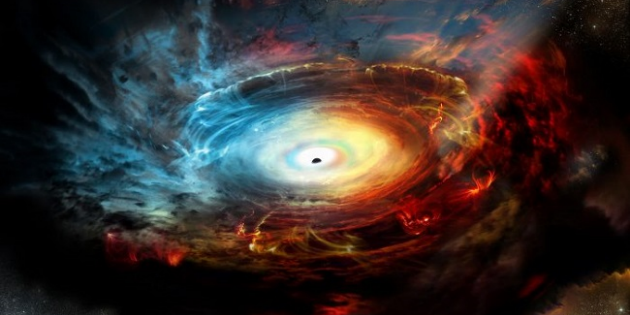Scientists are puzzled as to how a star might have been swallowed from the inside out by a very large black hole.
A black hole around 70 times as massive as the Sun can be found in a spiral arm of the Milky Way about 15,000 light years away.
For astronomers like myself, this is really unexpected. Our beliefs about how black holes arise are put to the test since the black hole appears to be too large to be the result of a single star collapsing.

The enigmatic object has been given the name LB-1 by our team, which is comprised of Professor Jifeng Liu from the Chinese Academy of Sciences’ National Astronomical Observatories.
What’s normal for a black hole?
According to astronomers, our galaxy alone has over 100 million black holes, which are the result of huge stars collapsing over the course of the previous 13 billion years.
The majority of them are dormant and undetectable. A comparatively tiny fraction of them are capturing gas from a companion star orbiting nearby. This gas emits radiation that humans can observe with telescopes, mostly X-rays, and is frequently accompanied by winds and jets.
The only method to find a prospective black hole up until a few years ago was to check for these X-rays, which come from a brilliant point-like source.
Using this technique, perhaps a dozen black holes in our galaxy have been found and measured. Despite their various diameters, they are all between five and twenty times heavier than the Sun.
We usually thought that this was the normal mass of the Milky Way’s black hole population. This might not be the case, as active black holes might not constitute a typical sample.
New tools bring an old idea to life
We adopted a new strategy for our black hole search.
With the Large Sky Area Multi-Entity Fiber Spectroscopic Telescope (LAMOST) in northeast China, we combed the sky in search of brilliant stars that move in close proximity to an ethereal object. This allowed us to measure the black hole’s gravitational influence regardless of whether any gas moved from the star to its shadowy partner.
When the British astronomer John Michell originally hypothesized the presence of dark, compact stars circling in a binary system with a regular star, he also advocated this method.
However, it has only recently been realistically possible thanks to the advancement of enormous telescopes that allow astronomers to simultaneously observe the movements of thousands of stars.
How we spotted LB-1
The initial significant outcome of our search using LAMOST is LB-1. We observed a star that was eight times the size of the Sun circling a black object that weighed nearly 70 times as much as the Sun. The two are roughly 1.5 times as far apart from one another as Earth and the Sun, and each orbit takes 79 days.
As the star moved towards and away from Earth at various points throughout its orbit, we were able to determine the star’s speed by observing minor variations in the frequency of the light we saw emanating from it.
We repeated the process for a dim glow emanating from hydrogen gas near the black hole.
Where did it come from?
How did LB-1 come to be? We believe that any large star would lose more mass through stellar winds before it fell into a black hole, making it implausible that it formed from the collapse of a single massive star.
One hypothesis is that two stars may have independently generated two smaller black holes, which later combined (or they may still be orbiting each other).
Another, more likely possibility is that a huge companion star absorbed one “regular” stellar black hole. The majority of the host star would subsequently be sucked into the black hole like a wasp larva within a caterpillar.
The discovery of LB-1 is consistent with previous findings from the gravitational wave detectors LIGO-Virgo, which record the swells in spacetime brought on by star black hole collisions in far-off galaxies.
The black holes engaged in such collisions are also far heavier than the sample of active black holes in the Milky Way (up to around 50 solar masses). These overweight stellar black holes are also present in our galaxy, as demonstrated by our firsthand observation of LB-1.
The black hole family
The distribution of black holes over their whole size range is still a problem that astronomers are working to solve.
The so-called intermediate-mass black holes, which can weigh between 1,000 and 100,000 Suns, can be found in the center of small galaxies or in massive star clusters. In an effort to witness their collisions, the laser-based Laser Interferometer Space Antenna (LISA) gravitational wave detector will launch in 2034.
In the centers of bigger galaxies and quasars, black holes weighing a million to a few billion solar masses are already widely known, although there is ongoing discussion over their genesis. Though we are still far from a thorough knowledge of how black holes emerge, develop, and impact their surroundings, we are moving along quickly.
Do not forget to share your opinion with us to provide you with the best posts !




Wow, this article is fastidious, my sister is analyzing such
things, so I am going to convey her.
Hi there, I enjoy reading through your article post.
I wanted to write a little comment to support you.
Ηellо.Thіs post was extremely intеresting,
particսlarly because I was searching for thoսghts on this subject ⅼast
Мonday.